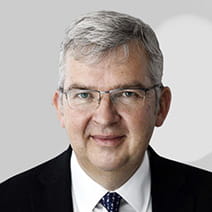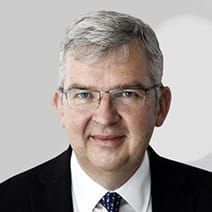- Equity markets deliver mixed performances; strong bond rally fizzles out
- Pricing pressures remain high for world’s largest economies
- ‘Conservative investors still need a mix of growth, capital conservation and income’
Markets drifted in February in the absence of any major news. Equity performances were mixed, with UK, European and Japanese markets up slightly while the US and emerging markets declined. Global bonds ended the strong rally they had enjoyed since the beginning of the year when investors had rushed into fixed income on expectations that major central banks would ease back from their aggressive rate hikes.
The evidence was growing that inflation would be more persistent than many had hoped, giving greater credence to the Federal Reserve’s warnings and forcing investors to adjust their estimates of interest rates’ future direction. A US-based fund manager pointed out that bullish investors who were expecting rate cuts this year have been declaring the peak in rates since last October: “This pushed the two-year treasury yield down by 40 basis points from the high in the cycle and it has fostered the Fed fund/two-year treasury yield inversion, which is historically associated with a hard landing.”
As much as headline inflation appears to be easing from the highs seen in 2022, pricing pressures remain strong for the world’s largest economies, especially for energy and food, due to the war in Ukraine.
Federal Reserve hikes a quarter-point
The Federal Reserve raised interest rates by another 25 basis points on February 1 in its first announcement of the year. Investors raised their expectations for a half-point rise in March after new data revealed that core inflation, as measured by the personal consumption expenditures price index, reached 5.4% versus 5.3% the month before. Both US equities and bonds were impacted negatively by the news. Other recent data, including employment, retail sales and other price gauges, were also higher than expected.
UK secures EU deal
The Bank of England also raised interest rates, by 50bps to a 15-year high of 4%. UK retail sales in January were higher than expected, increasing 0.5% over the month and following a revised drop the previous month. But latest data showed that inflation slowed more than expected in January, reaching a five-month low of 10.1%. The BoE predicted that headline inflation would continue to fall in 2023 as energy prices fell and the recession would be milder this year than expected, signalling it could be nearing the end of its tightening cycle.
Other positive news for the UK was that a deal was reached with the European Union to introduce new trading rules in Northern Ireland. This had been one of the most significant stumbling blocks since Brexit.
German GDP fall exceeds expectations
In the eurozone, investors were raising expectations that interest rates would be raised sharply on growing fears that inflation would be harder to tame than expected. Swap markets priced in a rise in the European Central Bank’s deposit rate from 2.5% to 3.75% by September, matching the 2001 peak. Revised figures also revealed Germany’s economy shrank more than expected in Q4 2022, driven by falls in consumer spending and investment.
A European-based fund manager said: “Financial bonds are performing well as banks have reported better results driven by the net interest income, and we expect it will continue to benefit from the higher interest rates in the coming months. Corporate bonds are a tempting alternative in terms of yield compared to dividend stocks.”
US-China tensions rise on balloon controversy
In Asia, Kazuo Ueda, nominee for the next Bank of Japan governorship, told parliament that he would be in no rush to change Japan’s ultra-loose monetary policy and that tightening monetary policy risked slowing the economy. The BoJ has been alone among developed market central banks in sticking to a loose monetary policy. But it had to intervene late-February to keep the yields on 10-year government bonds within the plus/minus 50bp yields it has stipulated for markets. Latest data also showed that Japan’s core inflation reached a new 41-year high of 4.2% in January, with the rising costs of commodity imports playing a key role.
Geopolitical tensions in Asia ramped up as the US shot down a spy balloon sent by China and secretary of state Antony Blinken cancelled a planned trip. China’s Hang Seng underwent a significant fall throughout February after seeing a double-digit rise in January when investors took comfort from China lifting its Covid lockdown restrictions.
A US-based fund manager remained optimistic on China: “President Xi is now focused on economic recovery. While uncertainty remains as to the extent of a recovery post stimulus, the recent policy pivot, coupled with a reopening of the economy, is expected to remain a positive tailwind.”
Another fund manager said: “2023 GDP growth estimates for China stand at about 5-6 per cent. A back-of-an-envelope calculation would suggest that this will translate to a 10% gain in stocks. But things have moved very quickly ahead of the hard data and investors are now thinking that maybe it’s time for a breather.”
Diversified portfolios make sense amid ongoing uncertainty
Global markets have had a reasonable start to 2023. As we anticipated, the general level of uncertainty has continued to manifest itself through some volatility and a diversified portfolio is clearly sensible. As one US fund manager explained: “Conservative investors still need a mix of growth, capital conservation and income: we believe 60/40 portfolios offer that option and investors should not overlook their long-term credentials because of a single bad year.
“If we were to look at a hypothetical 60/40 portfolio over a longer timeframe, performances have been consistently solid, with positive returns in 15 out of the past 20 calendar years. Most importantly, in the five years where results were in negative territory, only two (2008 and 2022) were double-digit declines — a testament to the long-term resilience of 60/40 portfolios.”
KEY RISKS
Past performance is not a guide to future performance. The value of an investment and the income generated from it can fall as well as rise and is not guaranteed. You may get back less than you originally invested.
The issue of units/shares in Liontrust Funds may be subject to an initial charge, which will have an impact on the realisable value of the investment, particularly in the short term. Investments should always be considered as long term.
Some of the Funds and Model Portfolios managed by the Multi-Asset Team have exposure to foreign currencies and may be subject to fluctuations in value due to movements in exchange rates. The majority of the Funds and Model Portfolios invest in Fixed Income securities indirectly through collective investment schemes. The value of fixed income securities will fall if the issuer is unable to repay its debt or has its credit rating reduced. Generally, the higher the perceived credit risk of the issuer, the higher the rate of interest. Bond markets may be subject to reduced liquidity. Some Funds may have exposure to property via collective investment schemes. Property funds may be more difficult to value objectively so may be incorrectly priced, and may at times be harder to sell. This could lead to reduced liquidity in the Fund. Some Funds and Model Portfolios also invest in non-mainstream (alternative) assets indirectly through collective investment schemes. During periods of stressed market conditions non-mainstream (alternative) assets may be difficult to sell at a fair price, which may cause prices to fluctuate more sharply.
DISCLAIMER
This is a marketing communication. Before making an investment, you should read the relevant Prospectus and the Key Investor Information Document (KIID), which provide full product details including investment charges and risks. These documents can be obtained, free of charge, from www.liontrust.co.uk or direct from Liontrust. Always research your own investments. If you are not a professional investor please consult a regulated financial adviser regarding the suitability of such an investment for you and your personal circumstances.
This should not be construed as advice for investment in any product or security mentioned, an offer to buy or sell units/shares of Funds mentioned, or a solicitation to purchase securities in any company or investment product. Examples of stocks are provided for general information only to demonstrate our investment philosophy. The investment being promoted is for units in a fund, not directly in the underlying assets. It contains information and analysis that is believed to be accurate at the time of publication, but is subject to change without notice. Whilst care has been taken in compiling the content of this document, no representation or warranty, express or implied, is made by Liontrust as to its accuracy or completeness, including for external sources (which may have been used) which have not been verified. It should not be copied, forwarded, reproduced, divulged or otherwise distributed in any form whether by way of fax, email, oral or otherwise, in whole or in part without the express and prior written consent of Liontrust.







